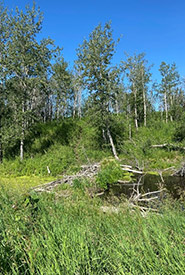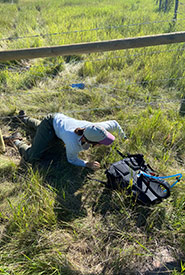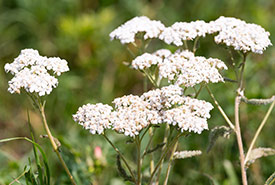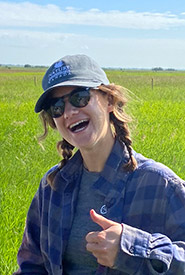Everywhere and all-around: Fence mapping in Alberta

Beaver damming activity, Collins Property, AB. (Photo by NCC)
It was a dry and hot, mid-July day in Red Deer, Alberta. Ashleigh and I, Nature Conservancy of Canada (NCC) interns and participants in the Canadian Conservation Corps program, were heading to the Collins property.
It was a wet spring, and the mosquitos and black flies were swarming with a vengeance, so we wore our full-length flannels and hiking pants. We left earlier than usual in hopes of avoiding the sweltering heat. Lunches were packed, coffees were poured into travel mugs, and bear spray, a first aid kit and an InReach satellite check-in device were stowed in our daypacks. Then we departed.
NCC’s Collins project features about 40 hectares of former pastureland that is being conserved in perpetuity. Over time, it will connect with other conserved lands in the area, forming an interconnected, undisturbed haven for wildlife. Located northwest of the village of Elnora, Collins is typical of the beautiful Red Deer area: a patchwork of rolling fields, groves of trembling aspen, and ponds brimming with cattails and waterfowl.

Ashleigh crawling under new fence, Collins Property, AB. (Photo by NCC)
We arrived just before 8:30 a.m. Our instructions from NCC conservation staff were to map the fences along the perimeter of the property as well as a double fence off its western edge. Gathering this information is important to inform fence-removal efforts in the future. Although helpful in preventing wildlife from meeting a premature end on asphalt, double fences are equally effective at preventing wildlife from accessing the essential resources and migratory pathways they rely on.
According to the Alberta Conservation Association and MULTISAR’s Alberta Landholder’s Guide to Wildlife Friendly Fencing, the total length of fences in southern Alberta and northeastern Montana would circle the Earth eight times.
That got me thinking. What is the cumulative length of fences in Alberta? What about in Canada? North America? The world? When you head to your next destination, try keeping an eye out for the omnipresent barbs and boards that you might normally overlook; the maze that wildlife must navigate to survive.
We changed out of driving shoes and into our hiking boots. As we walked, we looked for birds. My bird identification is spotty at best, but Ashleigh identified American coot and lesser scaup in the wetland beyond the crest of the hill.

Common yarrow flowers (Photo by NCC)
Smooth brome bowed and swayed around our feet, and harebells, while yarrow and alfalfa showed their sun-ripened colours. As usual, there were no paths or trails, and once the fence began to turn westward into the Collins property, we opted to bushwack down the steep brambles toward the ponds.
The satellite imagery on our mapping application promised a narrow foothold between the ponds, but with the damp spring we were having, the soft ground had succumbed to the creeping fingers of the marsh. To avoid the water, Ashleigh and I turned back and hiked east to catch the double fence as it cut through the wetland.
On and off, the fence’s rusted and aging wire rose like a sound wave, I thought to myself, as it disappeared into the tall grasses and emerged a few metres down. Together, Ashleigh and I mapped the few kilometres by adding geo-points and taking notes of damage, until finally, the fence ended.
Just after noon, our tasks were complete, and the maps were updated. The sun bore down on us at full force, and I gratefully removed my hiking boots, carefully brushing off my socks to avoid any unwanted travellers. Then I pulled out my lunch. We ate and then bid farewell to Collins. As we pulled away, I felt a warm, deep satisfaction inside, knowing that our work this day means the fence can soon be removed, repairing the fragmented ecosystem.
Notes from the author:
You can help reduce anthropogenic barriers to wildlife by taking part in a fence removal near you. The NCC regularly hosts fence removals, and you can keep an eye out for events in your local community. If you are constructing a fence yourself, consider a wildlife-friendly alternative and take measures to mark your fences and follow wildlife-friendly spatial guidelines.

Friendlier fence for wildlife (Photo source: Paige, C. 2020. Alberta Landholder’s Guide to Wildlife Friendly Fencing. P. 10.)


